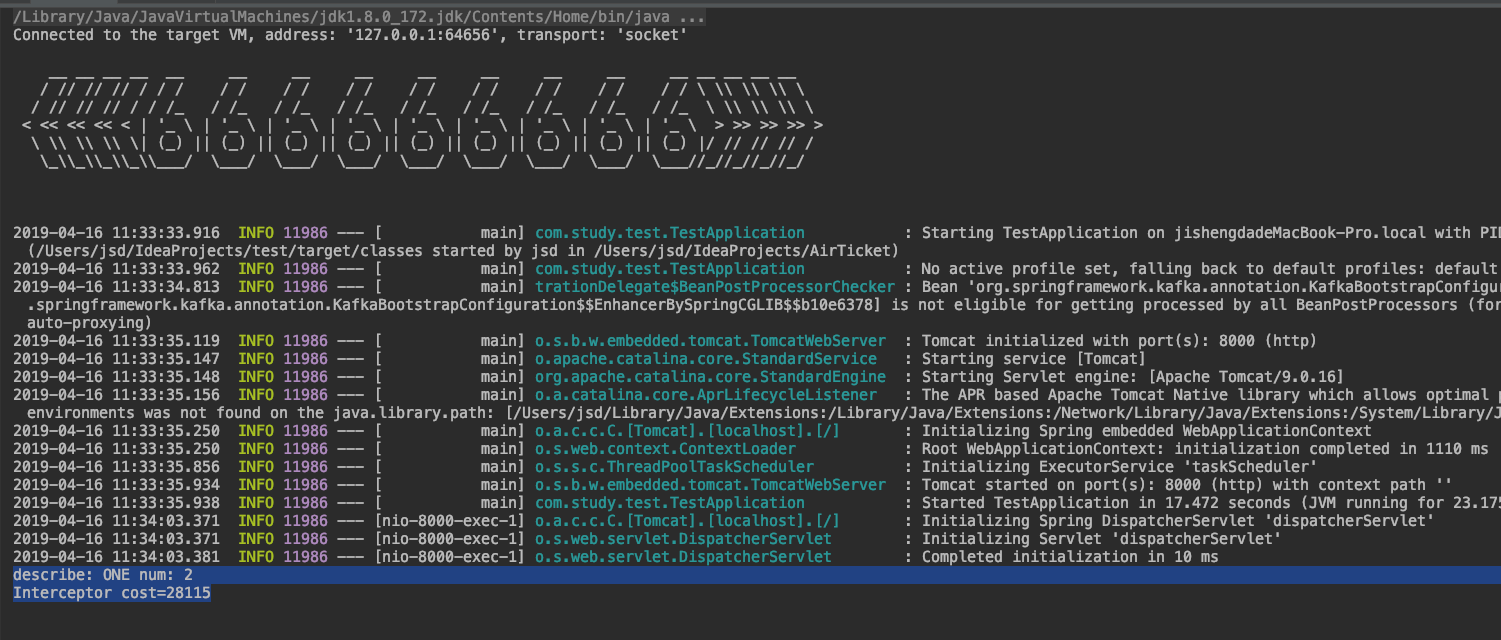Spring Boot 自定义注解 + 拦截器
先看一个大家比较熟悉的东西,for example
@Target({ElementType.CONSTRUCTOR, ElementType.METHOD,ElementType.PARAMETER, ElementType.FIELD, ElementType.ANNOTATION_TYPE})@Retention(RetentionPolicy.RUNTIME)@Documentedpublic @interface Autowired {boolean required() default true;}
嘿嘿,这是一个@Autowired注解源码。看下都有什么东西。
首先是三个注解:
- @Target
- @Retention
- @Documented
其次使用 @interface 定义这个类。
最后一个参数,required,我们可以这样使用: @Autowired(required = true)
一个一个解释:
@Target
看@Autowired源码中@Target后面跟了一大堆参数,里面有啥构造函数,方法,参数等等。我们猜一下,@Target注解,不就是告诉我们,你自定义的注解,可以在哪里使用麼。看下源码:
@Documented@Retention(RetentionPolicy.RUNTIME)@Target(ElementType.ANNOTATION_TYPE)public @interface Target {/*** Returns an array of the kinds of elements an annotation type* can be applied to.* @return an array of the kinds of elements an annotation type* can be applied to*/ElementType[] value();}public enum ElementType {/** 类,接口(包括注解类型)或枚举的声明 */TYPE,/** 属性的声明 */FIELD,/** 方法的声明 */METHOD,/** 参数的声明 */PARAMETER,/** 构造函数的声明 */CONSTRUCTOR,/** 局部变量的声明 */LOCAL_VARIABLE,/** 注解类型声明 */ANNOTATION_TYPE,/** 包的声明 */PACKAGE,/*** 类型参数声明** @since 1.8*/TYPE_PARAMETER,/*** 使用类型** @since 1.8*/TYPE_USE}
所以@Target就是告诉我们你自定义接口,在那里可以使用。
@Retention
这个看@Autowired中定义,参数有一个RUNTIME — 运行时间。那么这个参数是告诉我们在什么时候监控自定义参数的?老规则看下源码:
@Documented@Retention(RetentionPolicy.RUNTIME)@Target(ElementType.ANNOTATION_TYPE)public @interface Retention {/*** Returns the retention policy.* @return the retention policy*/RetentionPolicy value();}public enum RetentionPolicy {/*** 注解将被编译器忽略掉.*/SOURCE,/*** 注解将被编译器记录在class文件中,但在运行时不会被虚拟机保留,这是一个默认的行为*/CLASS,/*** 注解将被编译器记录在class文件中,而且在运行时会被虚拟机保留,* 因此它们能通过反射被读取到*/RUNTIME}
再详解一下:
- 如果一个注解被定义为 - SOURCE,则它将被限定在Java源文件中,那么这个注解即不会参与编译也不会在运行期起任何作用,这个注解就和一个注释是一样的效果,只能被阅读Java文件的人看到;
- 如果一个注解被定义为RetentionPolicy.CLASS,则它将被编译到Class文件中,那么编译器可以在编译时根据注解做一些处理动作,但是运行时JVM(Java虚拟机)会忽略它,我们在运行期也不能读取到;
- 如果一个注解被定义为RetentionPolicy.RUNTIME,那么这个注解可以在运行期的加载阶段被加载到Class对象中。那么在程序运行阶段,我们可以通过反射得到这个注解,并通过判断是否有这个注解或这个注解中属性的值,从而执行不同的程序代码段。我们实际开发中的自定义注解几乎都是使用的RetentionPolicy.RUNTIME;
- 在默认的情况下,自定义注解是使用的RetentionPolicy.CLASS。
@Documented
说明该注解将被包含在javadoc中
@interface
@interface用来声明当前类是一个注解
自定义参数
既然是自定义参数,你可以取任何名字,当然大部分都是value,name等。你同时可以指定默认值,后面加上default。比如:WriteRandom xxxx() default xxxxxx;
ok,那么我们知道了怎么自定义一个注解,先写一个
自定义注解:CustomInterface
import java.lang.annotation.*;@Documented@Target({ElementType.TYPE, ElementType.METHOD})@Retention(RetentionPolicy.RUNTIME)public @interface CustomInterface {/*** RAND_ONE*/WriteRandom one() default WriteRandom.RAND_ONE;/*** num*/WriteRandom two() default WriteRandom.RAND_TWO;}@Getter@AllArgsConstructor(access = AccessLevel.PRIVATE)public enum WriteRandom {/*** 第一*/RAND_ONE("ONE", 1),/*** 第二*/RAND_TWO("TWO", 2);/*** describe*/private String describe;/*** num*/private int num;}
既然定义好了注解,那么怎么获取呢?这个篇文章的主题是自定义注解+拦截器,所以我们把获取注解的地方写在拦截器里面了。下面开始写拦截器。
Handler
import org.springframework.util.StringUtils;import org.springframework.web.method.HandlerMethod;import org.springframework.web.servlet.ModelAndView;import org.springframework.web.servlet.handler.HandlerInterceptorAdapter;import javax.servlet.http.HttpServletRequest;import javax.servlet.http.HttpServletResponse;public class CustomInterfaceInterceptor extends HandlerInterceptorAdapter {long start = System.currentTimeMillis();@Overridepublic void postHandle(HttpServletRequest httpServletRequest, HttpServletResponse httpServletResponse, Object o, ModelAndView modelAndView) throws Exception {System.out.println("Interceptor cost="+(System.currentTimeMillis()-start));}@Overridepublic void afterCompletion(HttpServletRequest httpServletRequest, HttpServletResponse httpServletResponse, Object o, Exception e) throws Exception {}@Overridepublic boolean preHandle(final HttpServletRequest request, final HttpServletResponse response, final Object handler) {String result = buildLimitInfo(handler);if (StringUtils.isEmpty(result)) {System.out.println("---------------------");} else {System.out.println(result);}return true;}private String buildLimitInfo(Object handler) {if (handler instanceof HandlerMethod) {HandlerMethod handlerMethod = (HandlerMethod) handler;CustomInterface rateLimiter = handlerMethod.getMethodAnnotation(CustomInterface.class);String describe = rateLimiter.one().getDescribe();int num = rateLimiter.two().getNum();return "describe: " + describe + " num: " + num;}return null;}}
config
import org.springframework.context.annotation.Bean;import org.springframework.context.annotation.Configuration;import org.springframework.web.servlet.config.annotation.InterceptorRegistry;import org.springframework.web.servlet.config.annotation.WebMvcConfigurationSupport;@Configurationpublic class TestConfiguration extends WebMvcConfigurationSupport {@Beanpublic CustomInterfaceInterceptor customInterface() {return new CustomInterfaceInterceptor();}@Overridepublic void addInterceptors(InterceptorRegistry registry) {registry.addInterceptor(new CustomInterfaceInterceptor()).addPathPatterns("/**");super.addInterceptors(registry);}}
最后我们写Controller
Controller
import com.study.test.testInterfance.CustomInterface;import com.study.test.testInterfance.WriteRandom;import org.springframework.web.bind.annotation.GetMapping;import org.springframework.web.bind.annotation.RestController;/*** @author shengda.ji* @date 2019/4/15 12:03 PM*/@RestControllerpublic class TestCustomInterface {@CustomInterface(one = WriteRandom.RAND_ONE)@GetMapping(value = "/testCustomInterface")public String testCustomInterface() {return "testCustomInterface--testCustomInterface";}}
测试































还没有评论,来说两句吧...